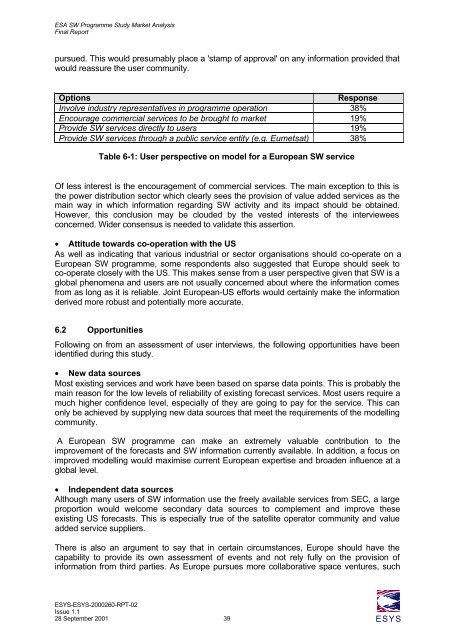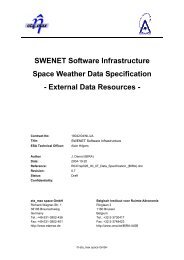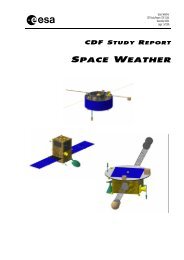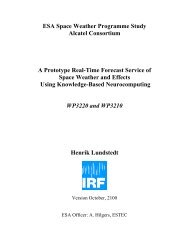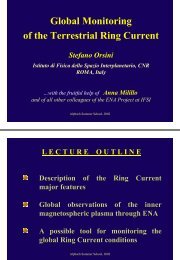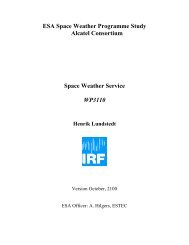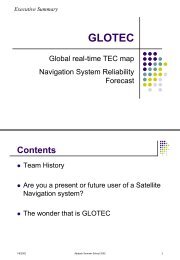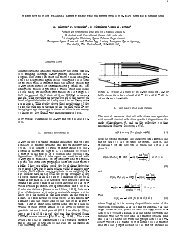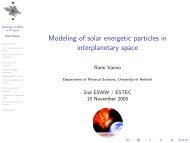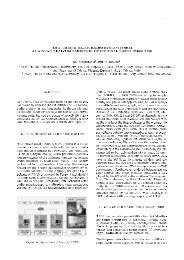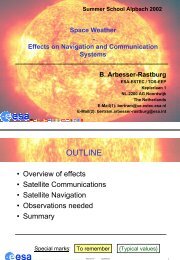market analysis final report v1.1 - ESA Space Weather Web Server
market analysis final report v1.1 - ESA Space Weather Web Server
market analysis final report v1.1 - ESA Space Weather Web Server
Create successful ePaper yourself
Turn your PDF publications into a flip-book with our unique Google optimized e-Paper software.
<strong>ESA</strong> SW Programme Study Market Analysis<br />
Final Report<br />
pursued. This would presumably place a 'stamp of approval' on any information provided that<br />
would reassure the user community.<br />
Options Response<br />
Involve industry representatives in programme operation 38%<br />
Encourage commercial services to be brought to <strong>market</strong> 19%<br />
Provide SW services directly to users 19%<br />
Provide SW services through a public service entity (e.g. Eumetsat) 38%<br />
Table 6-1: User perspective on model for a European SW service<br />
Of less interest is the encouragement of commercial services. The main exception to this is<br />
the power distribution sector which clearly sees the provision of value added services as the<br />
main way in which information regarding SW activity and its impact should be obtained.<br />
However, this conclusion may be clouded by the vested interests of the interviewees<br />
concerned. Wider consensus is needed to validate this assertion.<br />
• Attitude towards co-operation with the US<br />
As well as indicating that various industrial or sector organisations should co-operate on a<br />
European SW programme, some respondents also suggested that Europe should seek to<br />
co-operate closely with the US. This makes sense from a user perspective given that SW is a<br />
global phenomena and users are not usually concerned about where the information comes<br />
from as long as it is reliable. Joint European-US efforts would certainly make the information<br />
derived more robust and potentially more accurate.<br />
6.2 Opportunities<br />
Following on from an assessment of user interviews, the following opportunities have been<br />
identified during this study.<br />
• New data sources<br />
Most existing services and work have been based on sparse data points. This is probably the<br />
main reason for the low levels of reliability of existing forecast services. Most users require a<br />
much higher confidence level, especially of they are going to pay for the service. This can<br />
only be achieved by supplying new data sources that meet the requirements of the modelling<br />
community.<br />
A European SW programme can make an extremely valuable contribution to the<br />
improvement of the forecasts and SW information currently available. In addition, a focus on<br />
improved modelling would maximise current European expertise and broaden influence at a<br />
global level.<br />
• Independent data sources<br />
Although many users of SW information use the freely available services from SEC, a large<br />
proportion would welcome secondary data sources to complement and improve these<br />
existing US forecasts. This is especially true of the satellite operator community and value<br />
added service suppliers.<br />
There is also an argument to say that in certain circumstances, Europe should have the<br />
capability to provide its own assessment of events and not rely fully on the provision of<br />
information from third parties. As Europe pursues more collaborative space ventures, such<br />
ESYS-ESYS-2000260-RPT-02<br />
Issue 1.1<br />
28 September 2001 39 ESYS


